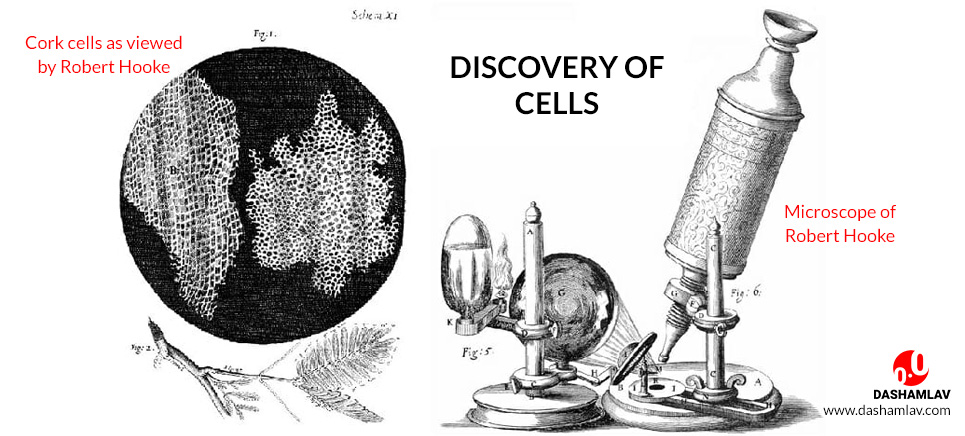Did you try observing your skin’s cells in your biology class? We all have done that. Today, we know a lot about the cells. But, there must have been someone who discovered it for the very first time. In fact, the discovery of cells is a story in itself. Let’s unfold it!
The Discovery of Cells
The cells were discovered by an English scientist named Robert Hooke. The year was 1665.
Robert Hooke had a primitive microscope. He used this microscope to perform his biological investigations. Once so happened that Hooke tried investigating the structure of a thin slice of cork. Cork is the outer bark of an Oak like tree Quercus suber.
After completing the investigation, he came to the conclusion that this piece of cork had tiny compartments in it. Robert Hooke imagined these compartments as “small rooms”. He called these rooms as cells.
The Word Cell was Inspired by Prisoner’s Cell
You may be surprised to know this but, it’s true! Just like today, cells were small rooms or compartments to lock up the prisoners. Sometimes, even the monks and nuns used cells for sleeping. The tiny compartments in cork slice seen by Robert Hooke during the experiment almost felt like the cells. Thus, the fundamental unit of life was a named cell! Intriguing, Isn’t it?
Robert Hooke, however, investigated the dead plant cells of cork. Thus, the cells were found to be empty. While he discovered the cell membrane, nothing inside those cells could be observed.

Living Cells of Plants and Animals
With the passage of time, better microscopes were built. With increasing magnifying power of the microscopes, we started exploring new questions about ourselves as well as our surroundings. Biologists started exploring living cells. Within the span of one year, between 1838 and 1839, two German scientists Schleiden and Schwann confirmed that both plants and animals were made up of cells. Another German Scientist named Rudolf Virchow started working on cells. His observations were based on Schwann’s work. These observations finally resulted in a general cell theory of organisms.
Cell Theory
How we understand the cells today, is attributable to this theory. According to this theory, every living organism is made up of one or more cells. These cells come from already existing cells. It states that all the functions of life occur within cells.
Discovery of Cell Organelles
More advanced microscopes opened doors to a plethora of information about cells and cell structure. The following table describes various cell organelles and their discovery.
| Cell Organelle | Year of Discovery | Discovered By | Remarks |
|---|---|---|---|
| Vacuole | 1676 | Antonie van Leeuwenhoek | Leeuwenhoek is credited for inventing the microscope. He was examining bacteria. It was during the examination that Vacuole was discovered by him. |
| Nucleolus | 1774 | Felice Fontana | Fontana discovered the nucleolus in eel cells |
| Nucleus | 1676-1677/1831 | Antonie van Leeuwenhoek/Robert Brown | It is believed that the nucleus was the first organelle. Leeuwenhoek observed a “lumen” in a Salmon Fish’s red blood cells. However, the nucleus was properly understood and described by Robert Brown in 1831. |
| Centriole and Centrosome | 1833 | Edouard Van Beneden | Both these organelles were later coined and described by Theodor Boveri in 1888. |
| Cytosol | 1835 | No Single Scientist Credited | H. A. Lardy introduced the term “cytosol” for the first time in 1965 |
| Chromosomes | 1842 | Karl Wilhelm von Nageli | Nageli discovered subcellular structures that were later known as chromosomes. |
| Mitochondria | 1857 | Albert Von Kolliker | It was studied mitochondria Kolliker in the muscle cells. However, it wasn’t recognized as a cell organelle. It was in 1894 that Richard Altmann recognized them as an important organelle of the cell. It was Carl Benda to coin the term “mitochondria” for this organelle in the year 1898. |
| Plastids | 1866 | Ernst Haeckel | While Haeckel discovered plastid, it was Andreas Schimper who gave the first clear definition of the plastid in 1883. |
| Golgi Apparatus | 1897 | Camillo Golgi | Golgi apparatus was named after Camillo Golgi in 1898. |
| Endoplasmic Reticulum | 1945 | Albert Claude & Keith Porter | It was discovered at the Rockefeller Institute. |
| Lysosomes | 1950s | Christian de Duve | Lysosomes were accidentally discovered by Duve through the fractionation technique. |
| Ribosomes | 1955 | George Palade | He described them as small particles in the cytoplasm that preferentially associates with the endoplasmic reticulum membrane. |
Use the citation below to add this article to your bibliography
"Discovery of Cells: Robert Hooke Discovered Units of Life." Dashamlav.com. Web. 12 June 2025. <https://dashamlav.com/discovery-of-cells-robert-hooke-discovered-units-of-life/>
Dashamlav.com, "Discovery of Cells: Robert Hooke Discovered Units of Life." Accessed 12 June 2025. https://dashamlav.com/discovery-of-cells-robert-hooke-discovered-units-of-life/
"Discovery of Cells: Robert Hooke Discovered Units of Life." (n.d.). Dashamlav.com. Retrieved 12 June 2025 from https://dashamlav.com/discovery-of-cells-robert-hooke-discovered-units-of-life/
